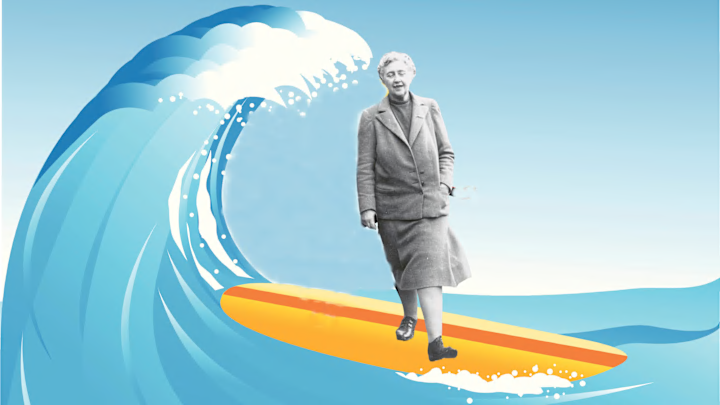Think about surfing and you’ll likely come up with a mental image of tanned young men and women on California beaches, hair bleached by the sun and sporting ripped abs. But from a historical perspective, you might as well think of crime novelist Agatha Christie hanging 10 in a “skimpy” emerald-green wool bathing suit and leather booties. That’s because Christie was an early—if unlikely—English pioneer of the sport.
Agatha Christie Books a Trip
In 1922, the 32-year-old author accompanied her husband, Archie, on a world tour to promote an upcoming exhibition intended to celebrate the achievements of the British Empire. (It featured such attractions as a butter sculpture of the Prince of Wales as well as elephants named Simla and Saucy.) The Christies deboarded in South Africa, where they were introduced to a local custom: surfing on Muizenberg Beach.
“Whenever we could steal time off—or rather when Archie could—we took the train and went to Muizenberg, got our surf boards, and went out surfing together,” Christie wrote in An Autobiography, a memoir published posthumously in 1977.
Initially, the couple did their best on flat boards—which Christie complained “jab you in the middle”—before graduating to “light curved boards.” Finding the wooden boards “easy to carry,” she quickly took to the activity despite a few self-admitted face-plants into the sand.
The couple continued the tour through Australia and New Zealand before finding themselves in Honolulu, Hawaii, where, as one might expect, Christie found plenty of waves to challenge her. It was probably slightly too advanced for a beginner, as Christie recalled that the she and Archie were warned out of the water by a concerned local.
Undaunted, Christie bought a wool bathing suit (which she described as “a wonderful, skimpy emerald green wool bathing dress”) as well as leather boots intended to protect her from sharp coral and set about perfecting her technique in Hawaii from August to October 1922. Speed was a big part of the thrill for her—she later wrote that surfing seemed like moving at “200 miles per hour”—and soon she was able to go from a prone position on the surfboard to standing up.
That latter feat took on some historical significance. In 2011, a researcher for the Museum of British Surfing named Pete Robinson found that Christie and her husband were likely among the first British citizens to learn how to surf upright.
“In the early 1920s very few British people were surfing and the only one we know about earlier than her, standing up, was Prince Edward,” Robinson told The Guardian.
Christie’s Novel Approach
It didn’t take long for Christie’s new pursuit to warrant a mention in her work. In her 1924 novel The Man in the Brown Suit, heroine Anne Beddingfeld finds herself in straddling a surfboard in Cape Town, South Africa.
That any Brit was surfing was unusual at the time, and that Christie, a woman, was doing it was even more curious. Women surfing had certainly predated her—a woman named Nakookoo triumphed in an 1887 Maui contest—but surfing was perceived as a male-centric sport for much of the 20th century. Men garnered the lion’s share of prize money and press coverage—an imbalance that has only started to change in recent years. (It was only in 2019 that the World Surf League mandated equal financial rewards to both men and women.)
It’s unclear to what extent Christie continued on with surfing later in life, though she was known to have frequented a writer’s retreat on Burgh Island that offered waves. It's plausible that, given her affection for the sport, she paddled out whenever she could.
Said Christie: “It is one of the most perfect physical pleasures that I have known.”
Read More Articles About Authors:
